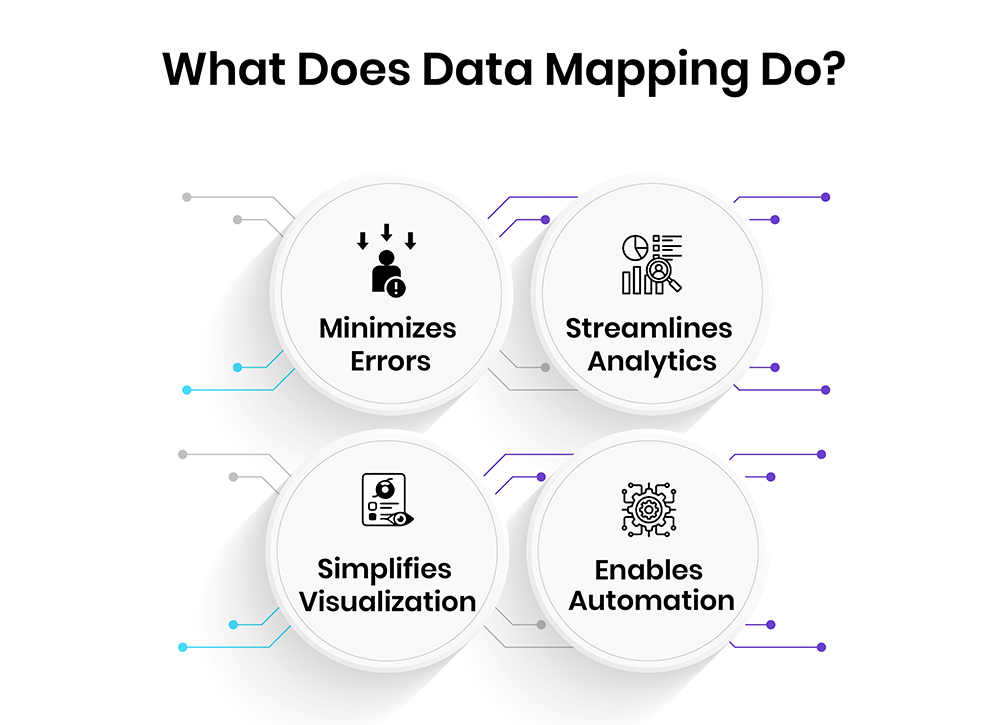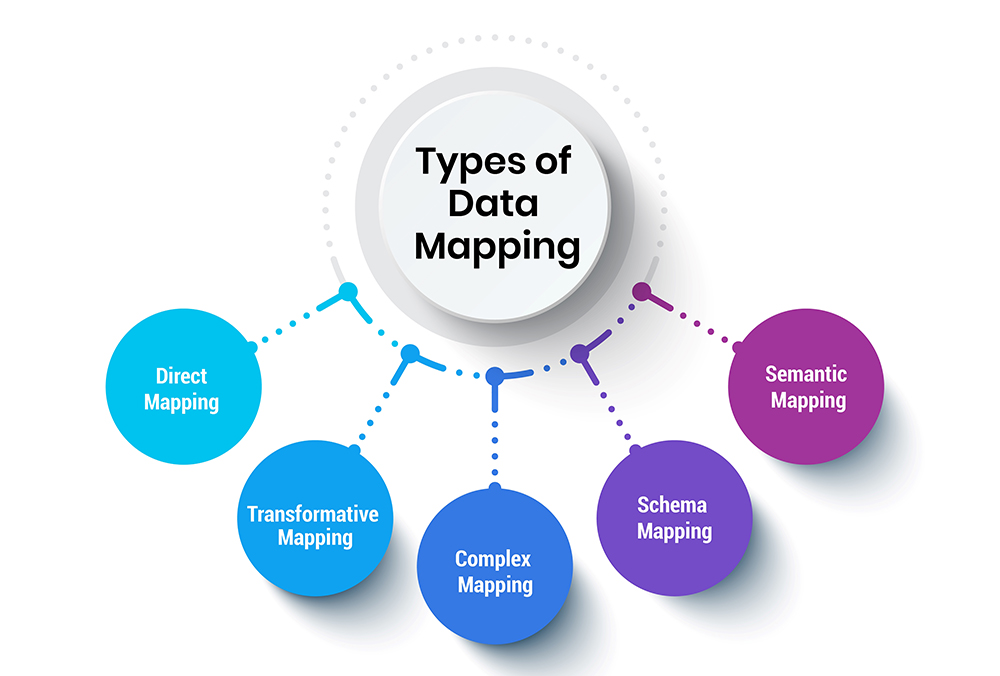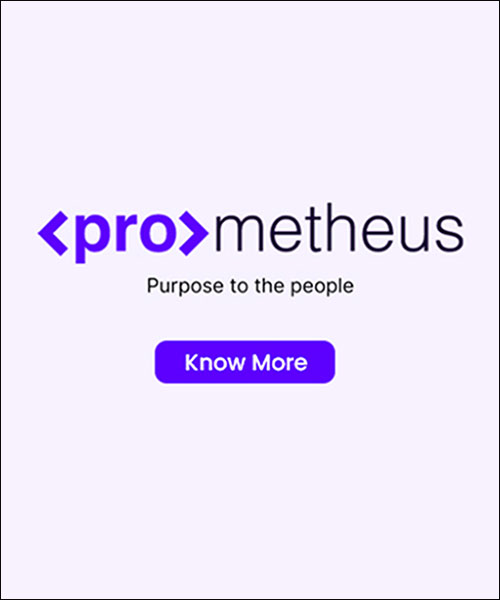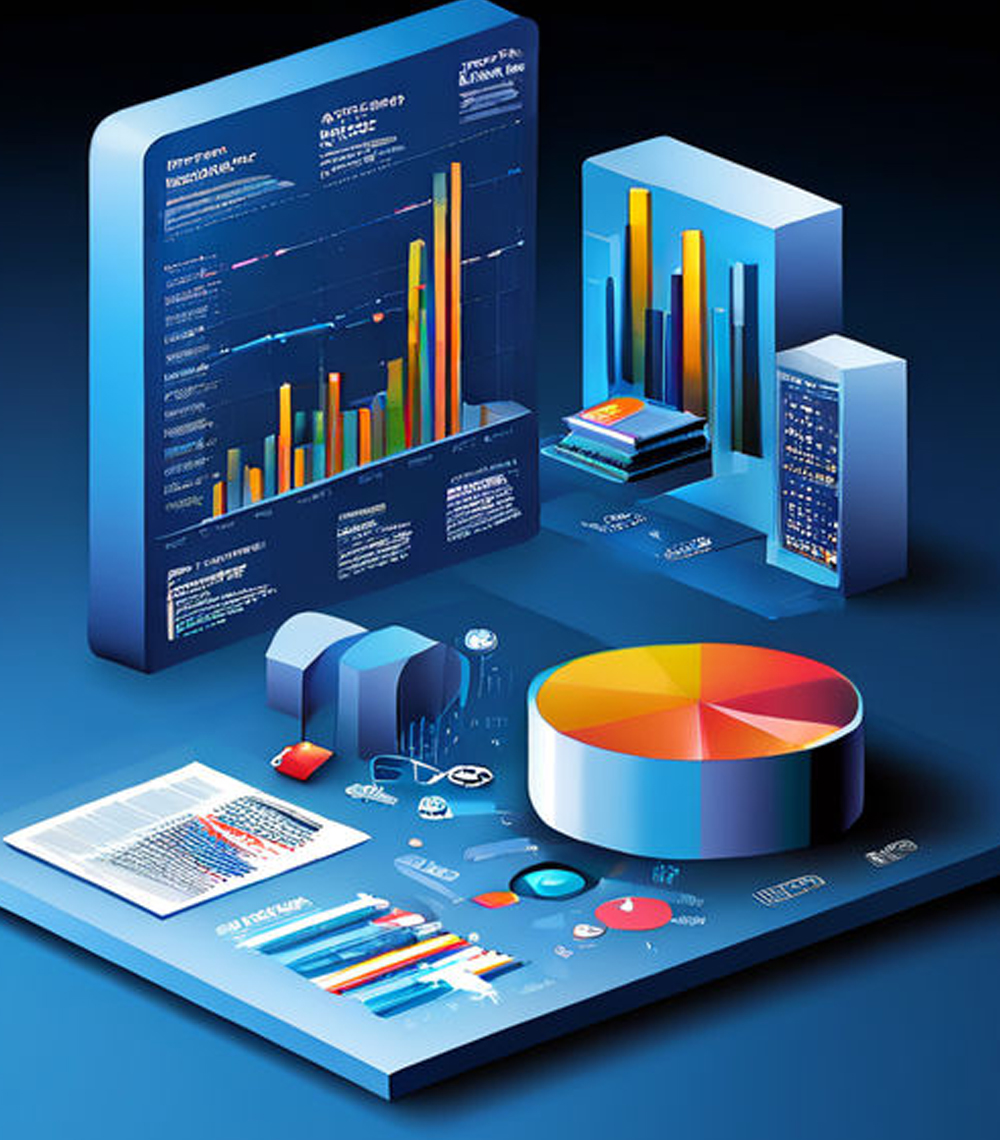
Data mapping refers to the process of matching and linking data elements from different data sets to create relationships and map them into a unified, centralized data store or schema. It helps seamlessly transfer, ingest, transform, analyze, and manage data from disparate sources.
In simple terms, data mapping creates a data map that provides a visual overview of how different data points connect to each other, much like a map shows us how to navigate between places. Just like taking a wrong route can cause problems when traveling, data mapping errors can undermine critical data analysis and management functions.
With proliferating data volume, variety and velocity, organizations need more efficient ways to understand connections between data to unlock value. This data deluge calls for intelligent data mapping techniques to accurately structure and streamline data for downstream analytics and decision-making.
Let's explore what data mapping entails and why it matters:
What Does Data Mapping Do?
Data mapping offers several benefits that make it an indispensable process:

- Minimizes Errors: Mapping data from multiple sources reduces inaccuracies in data use by standardizing data fields across systems. This enhances data reliability.
- Streamlines Analytics: Connecting data elements provides a unified view that drives faster, more contextual analysis and business intelligence.
- Simplifies Visualization: Data mapping gives a visual overview of data flows between systems that clarifies complex integrations. This aids in data monitoring and governance.
- Enables Automation: Intelligent mapping tools can automate linking data at scale, freeing up resources for high-value analysis. This facilitates efficient data management.
For data analysts, mapping tools are crucial to harness data effectively. Let's look under the hood to understand how data mapping works.
How Does Data Mapping Work?
Data mapping relies on clearly defining participating data systems and the relationships between their data fields. This forms the data mapping instruction set that guides tools on accurately linking data points.
The high-level data mapping workflow comprises:
- Identify Data: Outline the datasets and data fields to map from sources to destination schemas.
- Map Relationships: Associate source data components like tables/columns to target database components.
- Define Transforms: Specify any data transformations required to integrate source data into the destination.
- Test: Validate mapping accuracy using a sample dataset before full-scale deployment.
- Deploy: Upon testing, deploy the complete automated data mapping system.
Data mapping tools streamline these steps for reliable and scalable data consolidation. Let's look at some key components that power data mapping.
Key Data Mapping Components
Data mapping involves various interdependent components that collectively enable linking data seamlessly. Understanding these elements helps strategize mapping initiatives effectively.
-
Data Sources
These applications or services provide the data to map into unified systems. Confirm required access configurations exist before starting. -
Data Targets
Destination databases, apps, or services receive mapped data from sources. Align source and target data types for accuracy. -
Transformations
Custom operations like filtering, lookups, masking that alter data to integrate it from disparate sources into targets. -
Mapplets
Reusable transformation groupings to apply standard logic across recurring data mapping needs. -
Parameters
Constant values are fed into data mappings that can change dynamically between mapping runs. -
Functions
Custom logic like notifications inject additional capabilities into a mapping process.
With these core components constituting a mapping architecture, let's examine some common data mapping types.
Types of Data Mapping
There are several data mapping approaches, each addressing distinct use cases. Choosing the right mapping style is critical to ensure fitness to purpose.

-
Direct Mapping
The most straightforward mapping directly links equal fields from source to destination without modification. This one-to-one style works for basic data migration between similar systems. -
Transformative Mapping
This approach transforms source data to meet the destination schema. Operations like split, merge, encrypt or decrypt alter data during mapping. -
Complex Mapping
Multiple data sources are consolidated via extensive transformations into a destination database. This facilitates unified analytics. -
Schema Mapping
Used primarily for database integration, schema mapping connects source database objects like tables and columns to target database components. -
Semantic Mapping
Maps data from source model to destination model that differs significantly in structure and meaning. Critical for unrelated system interoperability.
In addition to these styles, data mapping can connect systems in real time or through batched execution. Now, let's explore leading data mapping tools.
Top Data Mapping Tools
Specialized data mapping software automates linking disparate datasets while minimizing errors and complexity. Here are seven stellar offerings:
-
Informatica Intelligent Data Management Cloud
As an integrated intelligent data platform, Informatica IDMC delivers a metadata-driven data mapping service. It leverages AI and machine learning to map massive datasets for holistic governance. -
Oracle Data Integrator
This high-performing bulk data movement and transformation engine offers extensive pre-built data integration. It scales for enterprise workloads through parallel executions. -
Talend Data Fabric
Talend simplifies data mapping with an easy visual designer to model dataset relationships. It shines in handling data of varying types and formats. -
Hitachi Vantara Pentaho
With expansive data connectivity and native big data support, Pentaho simplifies building automated data pipelines for analytics-ready data. -
AWS Glue DataBrew
As a serverless visual data preparation tool, DataBrew allows the preparation of data for analytics through an easy web UI without needing to code. -
MuleSoft
This integration platform as a service (iPaaS) uses a configuration-based approach without programming to interconnect apps, data, and devices. -
Xplenty
A code-free cloud data integration platform to simplify data mapping, transformation, data warehousing and more using intuitive GUIs.
Beyond proprietary platforms, open-source data mapping tools also abound, including Apache Nifi, StreamSets, Apache Airflow, and Singer. Let's look at proven mapping techniques next.
Data Mapping Techniques
Choosing suitable data mapping strategies is crucial to balance complexity, resources, skills, tooling, and use case uniqueness. Here are seven data mapping techniques worth evaluating:
-
Manual Mapping
This traditional tactic needs developers to manually code data associations between sources and destination. Better for small, one-off mappings. -
Semi-Automated Mapping
Combines coded logic with UI-based tools for moderately complex workloads. Strikes a balance between precision and automation. -
Automated Mapping
Maximizes productivity by fully automating mapping of even large datasets using metadata-driven tools. Minimizes errors. -
Schema Mapping
Links schemas from source to destination datasets directly. Handy for database migrations and reducing semantic gaps. -
Batch Mapping
Periodically maps and integrates data from sources to destinations on a schedule. Works for high-latency systems. -
Real-Time Mappin
Instantly streams live data from assorted sources into destination databases and apps as events occur. Enables responsiveness. -
Change Data Capture
Incrementally maps and propagates only changed data from sources to destinations for efficiency. Used extensively in cloud migrations and replication.
Organizations can choose between on-premise, cloud, or hybrid mapping approaches tailored to their needs and constraints. Data governance and lineage tracking capabilities should influence tool selection, too.
Real-World Data Mapping Use Cases
Now that we have covered data mapping essentials, let's see how they apply through common business use cases:
-
Database Migration
Transferring enterprise datasets between database servers or versions relies heavily on accurate schema and data mapping automation. This minimizes migration risks and downtime through phased transitions. -
Data Consolidation
Generating unified views via mapping customer data from CRM, ERP, billing, support systems into data warehouses, data lakes and master data hubs powers impactful cross-domain analysis. -
ETL Pipelines
Robust mapping of raw IoT sensory datasets streaming into data lakes lays the foundation for subsequent cleansing, transformation, and analytics through data pipelines. -
Cloud Migrations
For secure and efficient migration of data estates and workloads from legacy on-premises systems to cloud platforms like AWS, mapping tools help seamlessly connect disparate environments. -
Data Replication
Syncing disparate databases through continuous data replication enables operational resilience and analytics by maintaining current redundant copies. Reliable mapping underpins productive replication. -
Master Data Management
Master data mapping delivers unified views of business-critical data domains like customer, product, and supplier masters by consolidating domain subsets from across systems. -
Metadata Management
Connecting vital metadata from tools and environments using flexible mapping techniques centralizes, structures and standardizes metadata for consistent classification, search, lifecycle governance and reporting.
Using the right data mapping strategies unlocks substantial productivity and innovation across these common scenarios by streamlining data interoperability.
Data Mapping Tips and Best Practices
Approaching data mapping initiatives strategically is key to maximizing ROI. Here are the top tips:
-
Start with business goals
Begin by identifying desired mapping outcomes so technology choices align accordingly. Mapping data just because it is available risks wasted efforts and unintended consequences. -
Assess existing landscape
Thoroughly evaluate current infrastructure – systems, data stores, pipelines, models, schemas, standards, flows, and gaps. This informs mapping tool criteria and approach evaluations. -
Standardize early
Define organization-wide data standards covering architecture, quality, security, governance, and metadata even before starting implementations. This accelerates mappings. -
Design holistically
Coordinate disparate mapping efforts into a cohesive enterprise-wide plan spanning technologies, teams, and lifecycles. Think big, start small, scale fast. -
Embrace automation
Minimize manual coding by using visualized self-documenting mapping tools offering extensive automation through machine learning, APIs and cloud scale. -
Validate continuously
Govern mapped data quality through rigorous profiling, testing, monitoring, issue tracking, and annotations integrated across mapping pipelines. Fix errors sooner. -
Build iteratively
Use agile approaches to evolve iterative data mapping sprints, balancing early value delivery with user feedback and emergent needs. -
Keep it current
Schedule ongoing mapping reviews, maintenance and updates in alignment with changes in interconnected source systems and business requirements.
Using these best practices optimizes data mapping effectiveness while minimizing disruption.
Key Takeaways
Data mapping is an indispensable process that creates critical connectivity across datasets to derive unified value in modern data-centric enterprises. Using contextually aware and intelligent mapping techniques minimizes complexity while improving analytical performance, governance, and automation. As data growth and diversity accelerate across cloud-centered architectures, robust data mapping and self-service tooling help future-proof data interoperability, which is essential for sustained innovation.
Organizations that master strategic data mapping best practices will gain a sustained competitive edge by being better informed, more agile, and consistently compliant in leveraging data as their most valuable asset over time.


































